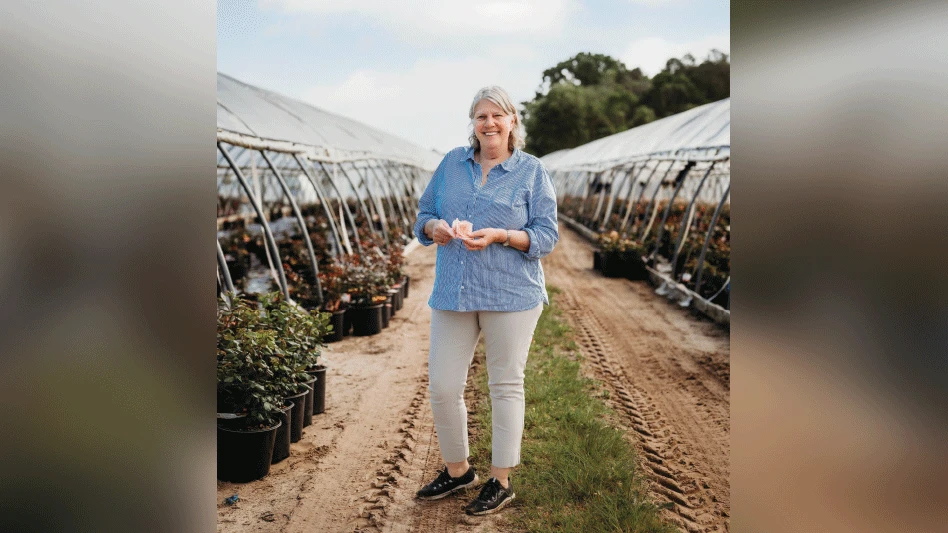
Photos by Bayside Gathering Co.
When Robin Rinaca took over the management of Eastern Shore Nursery of Virginia in 1980, it grew exclusively broadleaf evergreens, with field-grown azaleas, rhododendron and hollies. The nursery was strictly regional, shipping no more than 200 miles away to the Mid-Atlantic states of Virginia, Maryland, Pennsylvania and New Jersey. Eastern Shore wasn’t much different than it had been when it was founded in 1965. The nursery was propagating everything in its fields itself.
It was a nice little business, but Robin saw the potential for growth.
“We decided from the beginning to grow it organically and just slowly keep going with different product lines,” Robin says. “It has evolved over time. But if we depended on those product lines now, we’d probably be out of business.”
Luckily, Robin made the decision to diversify the business. And when two huge opportunities presented themselves, she was ready to seize the moment.


An unorthodox beginning
Robin may be the only nursery owner with a college degree in art. Her only background in horticulture was being her grandmother’s gardening helper. In the 1970s, she took a Master Gardeners class and met some pros from the nursery industry. Their conversations planted a seed for her, and she began thinking about running a nursery as a career.
She grew up in Virginia and was looking to be closer to family. Robin and her husband, Nick Covatta, started looking at businesses for sale in the area. They bought Eastern Shore in 1980, and for seven years, Nick stayed at his corporate executive job in New York City, and Robin ran the business.
She was in her 20s then, and the plan was when they decided to have children, he’d come work on the nursery and she’d raise the kids. But when the couple had their first child, Robin realized she didn’t want to stop running the business. And then after their second child was born, she still really liked the challenge of managing the nursery. So although Nick eventually did stop working in New York City, Robin was always the general manager of Eastern Shore.
“When I was younger, I would never have thought I’d be running a business, but it’s been fun and a challenge,” she says. And that’s what life is all about, or what it should be.”
Nick did a lot of corporate planning work for companies like General Electric and Gulf Oil, and once he moved to Virginia he was involved with the nursery, but he also had an equipment business in Norfolk, Virginia to keep him busy. He passed away in 2012.
“He was a great planner and a great businessperson,” Robin says. “I learned everything about what to do and not to do in a business from him.”

Jumping into fruit
The first big change Robin made was adding container production in 1982. Next, she expanded the product line to include deciduous flowering shrubs, hollies and more varieties of azaleas and rhododendrons. By 1994, 70 percent of the nursery’s production was in containers. Field production was stopped. Also in 1994, the nursery began growing ornamental and shade trees. The nursery also made a buying agreement with Stark Bros, which got them into the world of fruit tree production.
But as Eastern Shore’s fruit tree business grew, the nursery needed more product than Stark Bros. could fill. To meet the demand, Eastern Shore had to branch out and buy from other growers. Eventually, Stark Bros. stopped selling directly to garden centers entirely, focusing on e-commerce and mail order orders. At that point, Robin was fielding calls from her IGC customers. Many were wondering where they were going to get their fruit trees. With lots of experience as a contract grower for Stark Bros., Eastern Shore had the skills and the connections. There was a hole in the market, and the nursery had the opportunity to fill it. So Robin decided to develop her own brand.
“We’re not trying to be a Proven Winners,” she says. “We’ve pretty much done our own marketing and it’s mostly word-of-mouth with a website that supports consumers on fruit growing.”
The Hollybrook Orchards brand contains fruiting trees, shrubs and vines. It’s easily recognizable by the use of botanical illustrations on the tags. Eastern Shore hired 15 artists to make the artwork for the tags, which have become the calling card that separates it from other brands. The Audubon-esque illustrations are accompanied by extensive plant descriptions, planting and care information.
The branding has gained traction. Robin receives a lot of calls from customers specifically wanting to buy Hollybrook Orchards trees, which to her, proves that it’s doing its job.
“It’s interesting that from the beginning, we didn’t plan to spend $5 million on marketing, it was just going to be something to make our product distinctive and it’s really worked,” Robin says.”


Fruit challenges
The Hollybrook brand includes more than 150 varieties of fruit trees, plants and nuts, from standards like fig, pear and plum to more exotic options like kiwi, goumi and hybrids like the plumcot. But the biggest sellers are apples. There are more than 50 apple varieties in the Hollybrook brand. Robin aims for a mix of regional favorites and new disease-resistant varieties. Available options range from heirloom apples to popular choices in the Midwest, Mid-Atlantic and upstate New York, to newer breeds with genetics that resist scab, fire blight or bacterial disease. Many of the newer varieties come from Cornell University and Washington State University’s apple breeding programs.
Robin offers so many apple varieties because people are more particular about their apples than other fruit trees like peaches or plums.
“When people go to the grocery store, they know they’re buying a Honeycrisp or a Granny Smith or a CrimsonCrisp,” she says. “Apples are one that people look for by the variety. Everybody has their favorite.”
Fruit trees are not the easiest plants to grow. Though many think of fruit trees as one category, they are in fact very different plants with very different problems. Malus, Prunus and Pyrus (apple, plum, pear) all have their own set of diseases and insect pressure as well.
An expanded market
When Eastern Shore started growing fruit trees, many of those varieties were rated for USDA Hardiness Zone 4 or 5.
That widened the nursery’s potential market for all crops. Because the trees were shipping in a dormant state, they could ship to Maine in February. The trees would wake up when the weather warms up in their new destination. It opened up a much larger shipping area for Eastern Shore. Today, the nursery ships plants to Wisconsin, Maine, North Carolina and anywhere in between.
Besides the larger fruit trees, the nursery grows flowering and ornamental shade trees as well as lots of small fruit plants, like blueberries, Kiwis, raspberries, grapes as a complement to the trees. The nursery starts shipping the first week of February and hits its peak in March and April.
The nursery still propagates many of its own woody shrubs, like boxwood, azalea and hollies through rooted cuttings. But for its ornamental and fruit trees, Robin buys liners, which she then grows for a year to hit the seven gallon size.
About 80 percent of Eastern Shore’s business goes to independent garden centers. The remaining 20 percent is mostly rewholesalers with some business going direct to landscape contractors.
Eastern Shore’s trees are designed to be a garden center-sized product, not the 25 gallon or 2-inch caliper trees that provide instant impact in a landscape.
“We do a quality seven-gallon tree that someone can take home in their SUV and plant themselves,” Robin says.
Aside from the fact that the DIY homeowner typically doesn’t have heavy equipment to move those giant trees, Robin likes growing the 7 gallon size for another reason. She says it’s less cyclical. While the landscape business does really well when the economy is strong, it takes a dive when the economy tightens up. Over the 40 years she’s been running Eastern Shore, she’s found the garden center business to be more stable.
Like many, the pandemic provided a big boost to Eastern Shore. Robin noticed it especially in phone calls from customers. Before the pandemic, it seemed like the industry was ready to shrink. Of course, soon the phones would be ringing off the hook.

A knockout opportunity

In 2011, Star Roses and Plants discontinued production of finished roses. The company approached Robin and asked if she’d be interested in adding a large amount of finished roses to her production schedule. Robin considered it and then jumped at the opportunity.
Like the fruit tree situation a few years before, it was a chance to take the business to the next level. Robin evaluated the risk and reward and decided not to let the opportunity slip away.
“At that point, we were doing some KnockOuts and some shrub roses, and we said ‘OK, it’s worth a shot,’” Robin says. “They were just things that fell into our lap, but we said, ‘Let’s go for it’ and expand them and grow with them and go wherever they take you.”
Adding finished roses to the production schedule was a great fit. The roses are timed to start shipping mid-April, right as the fruit tree shipping slows down.
“It wasn’t an accident that we just happened to find product lines that would mesh with what we already did and we had the capacity to extend the shipping period,” Robin says.
Eastern Shore expanded its rose selection and now grows more than 200 varieties, including the best of Star Roses and Plants, Weeks Roses and David Austin Roses.

Production notes
On the production side, Eastern Shore divides its nursery by crop. There are specific growers responsible for fruit trees, ornamental trees and roses, for example. Robin’s team grows on 290 contiguous acres. Shrubs are grown in 300 overwintering houses that are covered with plastic each winter.
On the Eastern shore of Virginia, where the nursery is located, the weather stays warm until after Thanksgiving. That’s when Robin has her crew start covering the hoop houses.
Once everyone returns from the holidays, the Eastern Shore team begins planting roses. Once those are done, they go right into planting trees.
“There’s not too many days of the year that you can’t work outside here,” Robin says.The biggest challenge is having all the roses ready to ship and shipping them within the window that gets them to their destination IGC in time for Mother’s Day sales. That can be tough, especially in years without warmer, sunny springs.
Eastern Shore has 45 employees year-round and adds another 20 seasonally. But Robin likes to spread the workload out to minimize the need for seasonal help.
Irrigation water comes primarily from surface water pumped out of eight ponds on the nursery. The growing media mix is composted pine bark and sand.
So now that Robin has been running Eastern Shore Nursery of Virginia for more than 40 years, what does the future hold?
“Nothing dramatic,” she laughs. “We keep looking for opportunities and plants that fit into our mix and our season of shipping, where we can expand and grow, and plants we can grow well.”
She’s an avid gardener, especially at her family’s historic house and grounds, Bowman’s Folly. She loves living on the seaside and taking her boat out on the water.
Travel is a passion. She visits her daughters in Boston and New York often and travels to Italy several times a year.
Robin will turn 70 this year, but she has no plans to stop running the nursery. She still loves what she does.
“I’ve always liked to work, and I like challenges,” she says. “So I’m not bored with it. If I didn’t like it, or I guess if I wasn’t making money, it wouldn’t be a lot of fun. But it’s still fun for me.”

Explore the June 2024 Issue
Check out more from this issue and find your next story to read.
Latest from Nursery Management
- Pennsylvania Horticultural Society shares top gardening trends from 2025 Philadelphia Flower Show
- California Spring Trials 2026 dates announced
- Les Evans promoted to DRAMMwater segment manager, Al Zylstra to retire
- Hoffmann Family of Companies to acquire N.G. Heimos Greenhouses
- GIE Media Horticulture Group wins five regional 2025 Azbee Awards of Excellence
- How to create a sustainable plant nursery
- Grant awarded to test western U.S. wood species for use as wood fiber potting substrate
- Pennsylvania Horticultural Society announces 2025 Gold Medal Plant winners





